#taffeta
Photo
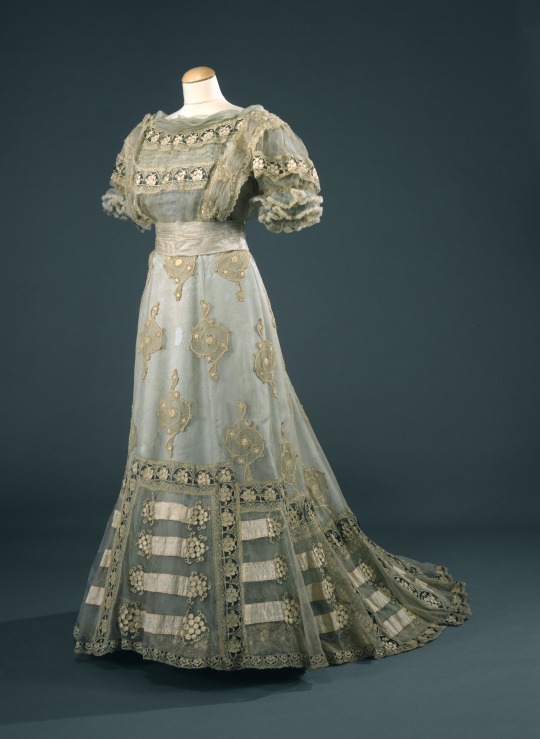
Dress
1900s
Portugal
Museu Nacional do Traje (Accession Number: 3669)
#dress#fashion history#historical fashion#1900s#20th century#turn of the century#edwardian#portugal#1900#1905#1909#silk#taffeta#tulle#off white#blue#museu nacional do traje#popular
2K notes
·
View notes
Text
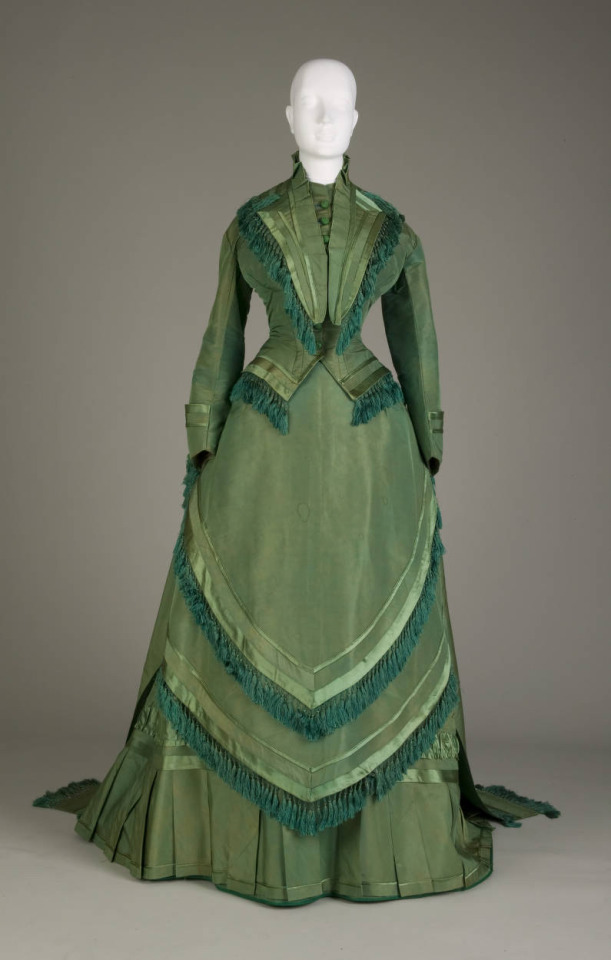
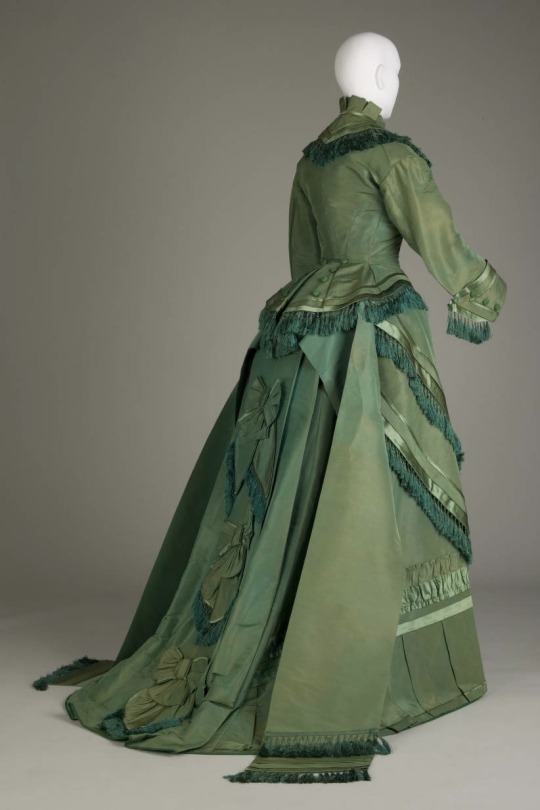
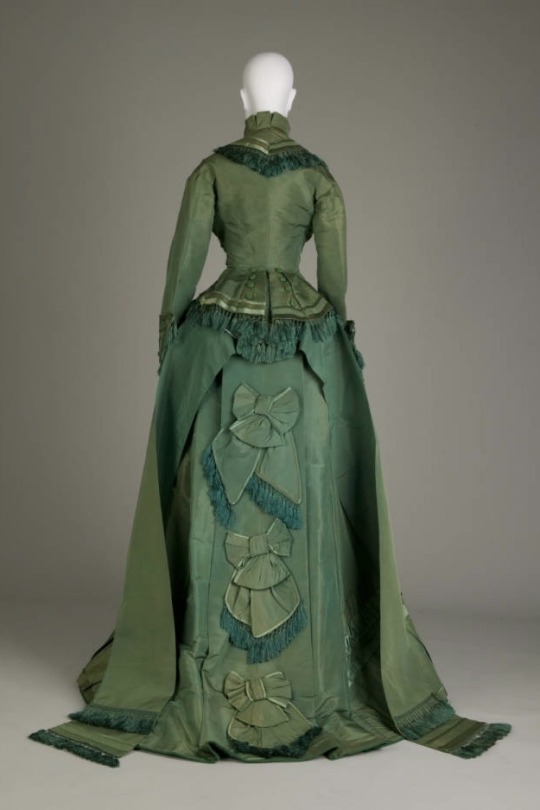
Green taffeta wedding dress, 1874, American.
Worn by Harriet Elder.
Chicago Historical Society.
#womenswear#extant garments#dress#silk#taffeta#19th century#chicago historical society#green#USA#1874#1870s#1870s dress#1870s usa#1870s extant garment#Harriet elder
298 notes
·
View notes
Text
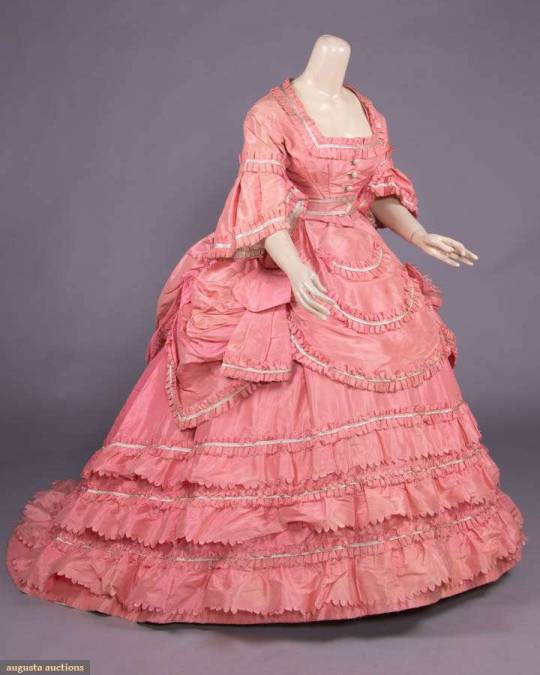

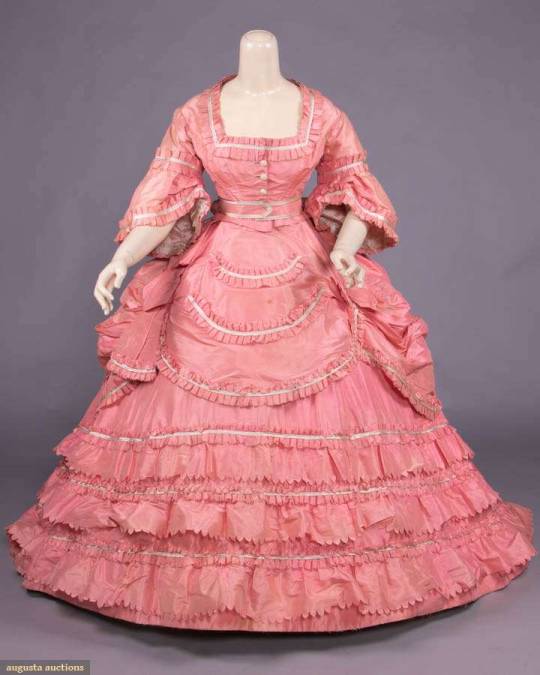
Today in "is it a dress or is it a layer cake" is this confection from 1872. There are so many layers here, it's a little difficult to tell where one ends and another begins! The listing is from Augusta Auctions, and it indicates that it's a four-piece gown--so indeed, parts of it can be added or taken away. The polonaise overskirt (the puffy part of the hips) is a callback to the 18th century, while the neckline is thoroughly 1870s.
The taffeta layers are edged in what's called double-boxed pinked pleats. The scalloped design is also certainly part of a 1700s revival (not to mention those sleeves!).
I absolutely adore the color of this pink, too. It reminds me of some of the cherry blossoms one might see in spring, especially with the trim.
#fashion history#costume history#historical costuming#textiles#silk dress#victorian fashion#threadtalk#late victorian fashion#costume#taffeta#scroop
802 notes
·
View notes
Photo

Worth “Byzantine Dress,” 1904
#worth#fashion#dress#gown#beaded#train#fur#1900s#20th century#taffeta#pearls#sequined#rabbit fur#edwardian
156 notes
·
View notes
Text

US Vogue November 1, 1951
Sunny Harnett in a little black tuller silk taffeta ball gown. Long basque bodice belted at the waist; the skirt a shower of flat pleats. By Larry Aldrich. Tabarin stockings in “Sonyette” color. Faille bag by Virginia Art. Rhinestone choker necklace by Marvella.
Sunny Harnett dans une petite robe de bal noire en taffetas de soie Tuller. Long corsage basque ceinturé à la taille ; la jupe une pluie de plis plats. Par Larry Aldrich. Bas Tabarin teinte "Sonyette". Sac en faille par Virginia Art. Collier ras de cou en strass par Marvella.
Photo Frances McLaughlin Gill
vogue archive
#us vogue#november 1951#fashion 50s#1951-52#fall/winter#automne/hiver#larry aldrich#sunny harnett#frances mclaughlin gill#tabarin#sonyette#virginia art#marvella#ball gown#robe de bal#little black dress#petite robe noire#taffeta#taffetas
83 notes
·
View notes
Photo

La Mode illustrée, no. 7, 16 février 1863, Paris. Toilettes de Bal. Ville de Paris / Bibliothèque Forney
Description de toilettes:
Jupe en taffetas bleu, garnie avec deux volants doubles, tuyautés à très-gros plis, ayant (le premier volant) 12 et 10 centimètres de hauteur. Sur cette jupe, robe de tulle blanc, composée de quatre bouillonnés disposés en ondulations; le dernier bouillonné est terminé par une blonde blanche, ayant 8 centimètres de hauteur, surmontée d'un ruban de velours bleu, ayant 3 centimètres de largeur; chaque bouillonné est séparé du suivant par un même ruban (le velours. A chaque pointe des bouillonnés, sur le velours bleu, se trouve une rose rosée sans feuillage. Le corsage est en taffetas bleu, et fait en forme de corsage bernois, c'est-à-dire très-bas; il est surmonté d'une haute draperie en tulle blanc; une rose est posée sur la pointe supérieure, c'est-à-dire devant le corsage; les manches sont des bouillonnés en tulle blanc ornés d'une rose, bordés d'une bande de taffetas bleu, terminée par une dentelle blanche, et surmontés d'une épaulette tuyautée eu taffetas bleu. Coiffure de roses rosées et de rubans de velours bleu.
Robe en satin jaune doré. Le bas de la jupe est garni avec une dentelle noire, ayant 6 centimètres de largeur, disposée en treillage; une dentelle noire étroite est posée sur le côté uni (opposé au dessin). Corsage décolleté, garni d'une berthe reproduisant le treillage de la jupe; manches courtes, composées (l'un large bouillonné de satin, et d'un second bouillonné moins volumineux en tulle blanc. Coiffure de grenades rouges; collier et bracelet en corail rouge; large broche assortie, c'est-à-dire en corail rouge à pendeloques.
—
Skirt in blue taffeta, trimmed with two double ruffles, piped with very large pleats, having (the first ruffle) 12 and 10 centimeters in height. On this skirt, dress of white tulle, composed of four bubbles arranged in undulations; the last bubble is terminated by a white blonde, 8 centimeters high, surmounted by a blue velvet ribbon, 3 centimeters wide; each bouillonné is separated from the next by the same ribbon (the velvet. At each point of the bouillonné, on the blue velvet, is a dewy rose without foliage. The bodice is in blue taffeta, and made in the shape of a Bernese bodice, it is to say very low; it is surmounted by a high drapery in white tulle; a rose is placed on the upper point, that is to say in front of the bodice; the sleeves are swirls in white tulle adorned of a rose, edged with a band of blue taffeta, finished with white lace, and surmounted by a piped epaulette of blue taffeta. Headdress of pink roses and blue velvet ribbons.
Golden yellow satin dress. The bottom of the skirt is trimmed with black lace, 6 centimeters wide, arranged in a trellis; a narrow black lace is laid on the plain side (opposite to the design). Low-cut bodice, trimmed with a bead reproducing the trellis of the skirt; short sleeves, composed (one wide bubbled with satin, and a second less voluminous bubbled with white tulle. Hairstyle of red pomegranates; necklace and bracelet in red coral; large matching brooch, i.e. in coral red with pendants.
#La Mode illustrée#19th century#1800s#1860s#1863#periodical#fashion#fashion plate#color#retouch#description#Forney#dress#toilette#ensemble#ball#gown#taffeta#blue#yellow#satin#trellis#bubbles
216 notes
·
View notes
Text

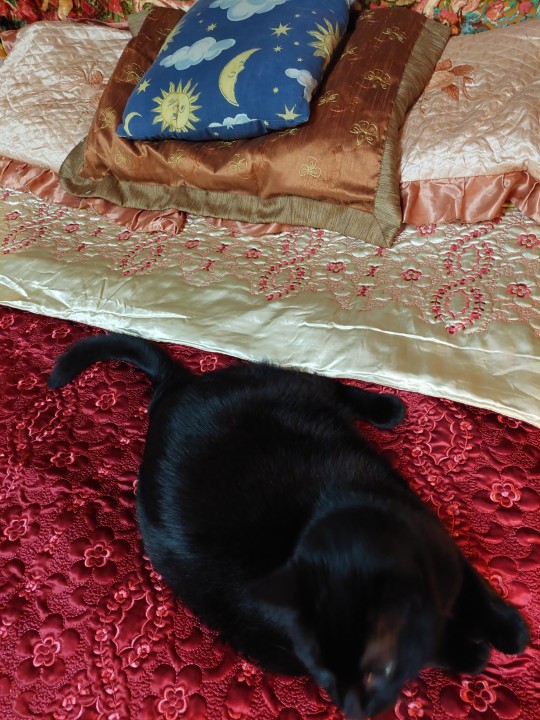
the new vintage vestor italian reversible taffeta bedspread be hittin 😎 cant believe i found it mint w tags for 13 bux (it was 50 to dry clean it but worth it! these go for 1200 usd n mine is miraculously from the 1950s 🤯🤯🤯)

im still puttin a throw on it tho cuz my cats back claws....
#decor#homedecor#whimsigoth#whimsigothic#vintage#antique#italian#taffeta#thrifted#my style#aesthetic
97 notes
·
View notes
Text

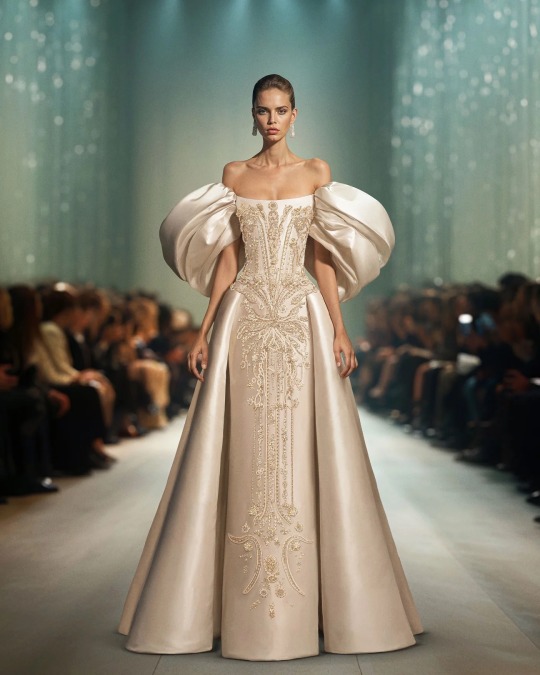
Saiid Kobeisy |Spring Summer 2024 Haute Couture
#Saiid Kobeisy#spring 2024 couture#fashion#runway#high fashion#blaze🔥#fashion show#paris fashion week#runway fashion#gowns#regal#stunning#red carpet looks#haute couture#couture#pfw 2024#taffeta
21 notes
·
View notes
Text
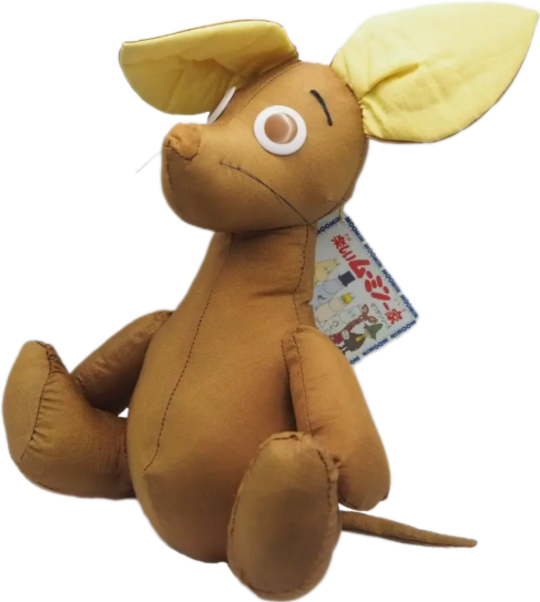
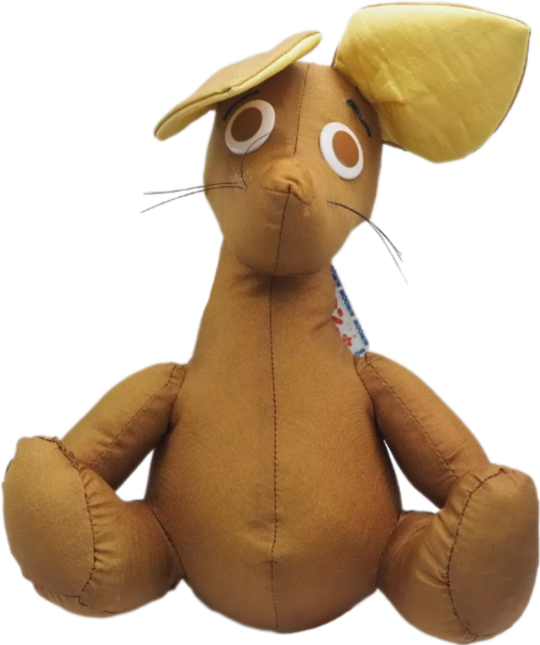
1995 Banpresto Sniff Moomin Taffeta Plush
18 notes
·
View notes
Text
Taffeta Tuesday

Taffeta evening dress ca.1855 from the Museum of Fine Art Boston collection.
Description from MFA Boston:
"Yellow taffeta dress with wide, flaring neckline, tightly fitted bodice, short sleeves; skirt full all around with three flounces of yellow and white brocade border taffeta; triangular panels front and back of bodice and edges of sleeves trimmed with part of brocade taffeta."
#fashion history#19th century fashion#1850s fashion#yellow#taffeta#extant garments#mfa boston#dress history
31 notes
·
View notes
Text
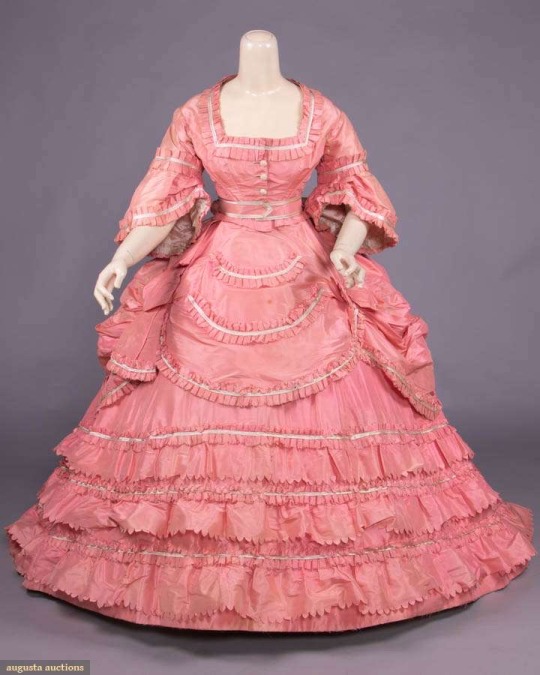
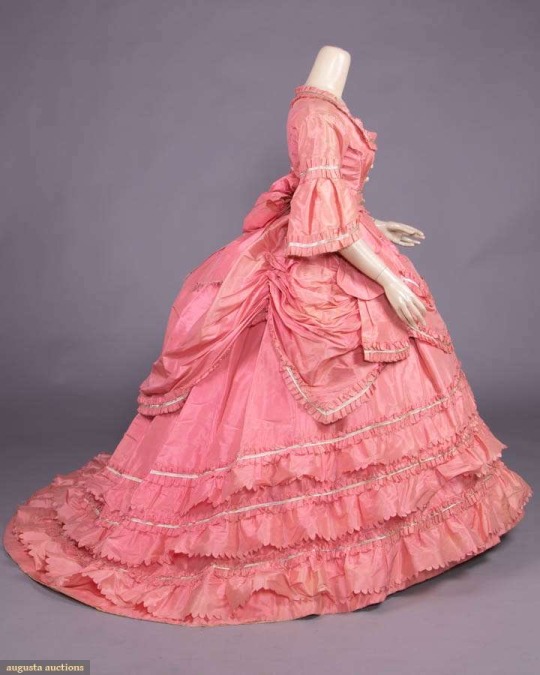
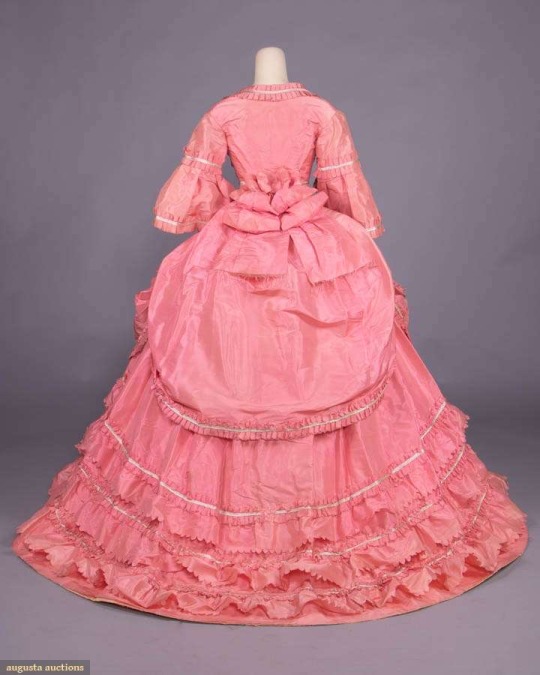
Pink Taffeta Ballgown, ca. 1872.
Augusta Auctions.
#pink#taffeta#womenswear#extant garments#dress#silk#ballgown#19th century#1872#1870s#1870s dress#1870s ballgown#1870s evening#augusta auctions#1870s extant garment
414 notes
·
View notes
Text

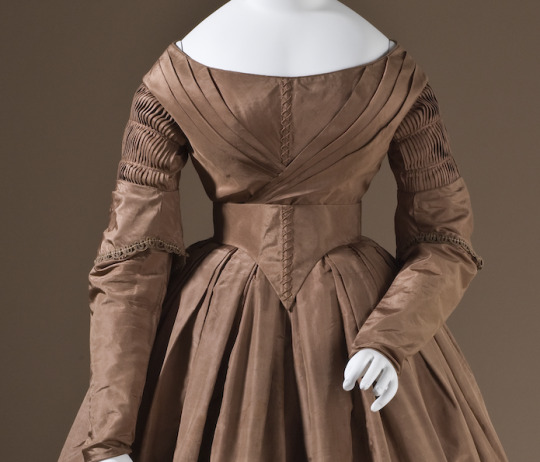
Brown dresses are often overlooked and so, too, is the entirety of the 1840s in terms of fashion. And that's understandable to some extent, buttressed as it is by the flamboyant 1830s and the young Victoria 1850s full of confectionary gowns and elegance.
But I have a soft spot for the 1840s, not the least of which is for the use of both monochrome and enterprising pleating and ruching.
This gown from 1845, from LACMA, has so much going on for it--but it all requires a closer look (and of course I've provided that). Making good use of sturdy silk taffeta, the modiste created an absolutely stunning bodice and sleeve to this dress, employing 18th century influences (like that faux lacing) and yet still predicting the drop shoulder that was so popular a few years later. The sleeves themselves are a work of art, with various techniques combined to add texture and dimension.
So what if it's brown? It's a marvel.
#historical costuming#costume history#silk dress#textiles#costume#fashion history#threadtalk#victorian fashion#history of fashion#taffeta dress#extant garments#taffeta
317 notes
·
View notes
Text

consulted the books re:iridescence in woven fabrics
context for the books:
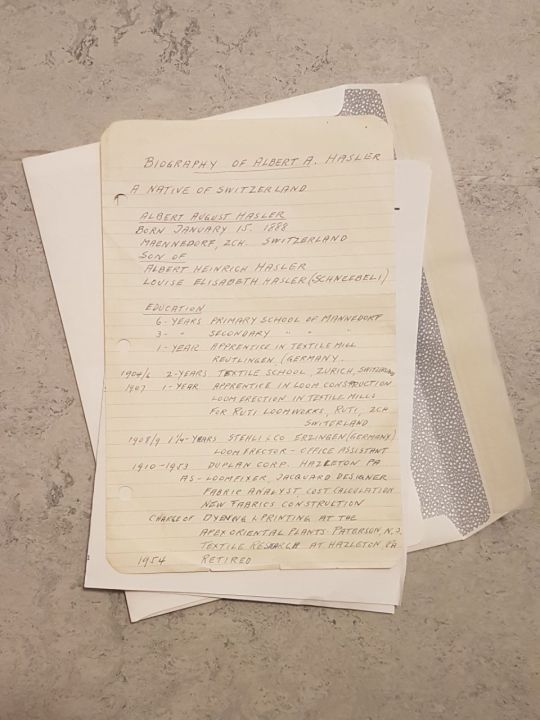

they are from 1905/1906, belonged to Albert A. Hasler and detail how to weave different kinds of silk fabrics. they belong to me now because they are big, heavy, not in great shape, most museums have better versions of it and my mother knows someone who knew someone and i weave. Period.
I am still confused about when a fabric is considered iridescent (though i think that confusion is solved when it is thought of as more of a scale than an either/or situation) and interestingly, the Zurich Silk Weaving School has things to say about it.
(Info in german/french i will put a short english conclusion but it is bedtime and i already transcribed this whole thing so u know)
"Taffetbindung
ist die einfachste und älteste bindung. sie wird durch kreuzung der geraden mit den ungeraden kettfäden hervorgebracht. von 2 kettfäden liegt der eine über dem ersten und unter dem zweiten schuss und der andere unter dem ersten und über dem zweiten schuss. die taffetbindung umfasst den kleinst möglichen fadenrapport; die fäden des einen systems überspringen stets nur einen faden des anderen systems, vollziehen somit die kürzeste bindung, wesshalb dem taffetgewebe am meisten festigkeit verliehen werden kann.
Bemerkung
Schwarzer Taffetas wird stets in tout cuit angefertigt und zwar gewöhnlich vom 22er - 33er Stich 3 oder 4 Fädig mit Gros du Rhin, schwerere mit Gros de Chine bezeichnet. Wird auf Glanz oder(durcgestrichen ?to) Geschmeidigkeit der Waare gesehen, so ist sie gut zu reiben. Um ihr mehr Glätte zu geben wird sie am fertigen Stück nochmals aufgerollt. (enrouliert) Schwarze Taffetas findet Verwendung zu Futter, Cravatten, Regenschirmen etc.


Taffetas caméléon wird in der Regel mit einer einfarbigen Kette und zweierlei Schuss von verschiedener Farbe hergestellt. Die beiden Schussfarben werden mittels eines zweizäpfle-Schiffchens zusammen in die gleiche Kettöffnung eingetragen, wobei die eine Farbe an der vordern, die andere an der hintern Wand des Schiffchens austritt. Da jede Schussfarbe im Kettfach stets die gleiche Stelle einnimmt d.h. immer entweder als erste oder als zweite Farbe ersehen, so herrscht in der einen Richtung die erste, und in der andern die zweite Farbe vor. Der Unterschied zwischen Glacés und Caméléon besteht somit darin, dass erstere nur eine Schussfarbe aufweisen, wogegen letztere in Zweischussfarben schillern."
I included the general information given about the Taffetas (because fun) but the bit i'm interested in is - who would've guessed - the description of "taffetas caméléon"
He describes a shuttle with two chambers for two colours of weft (the warp is a single colour) with one emerging from the back side of it, one from the front. using this shuttle to insert two differently coloured weft threads into the same shed gives the shimmering (iridescent) effect to the cloth. he describes either color being dominant depending on the angle you view it from. which makes sense if you have the threads emerging from both sides of the shuttle. they would lie next to each other in the same way in each pick.
but here's the frustrating thing: without sunlight and a magnifying glass i really really can't tell which two colours are supposed to coexist in the weft of that last sample! WHY!
(what i CAN tell is that the pink sample top left is woven with magenta warp and olive green weft and it's fucking gorgeous)
27 notes
·
View notes
Text

US Vogue November 1, 1951
Jean Patchett wears a ball gown by Charles James, white evening collection. The bodice is a long curvature stem of black velvet above petals of black satin, above that, 25 yards of puffy, puffy white taffeta.
Jean Patchett porte une robe de bal signée Charles James, collection de soirée blanche. Le corsage est une longue courbure tige de velours noir au-dessus des pétales de satin noir, au-dessus, 25 mètres de taffetas blanc gonflé et gonflé.
Photo Horst P. Horst
vogue archive
#us vogue#november 1951#fashion 50s#1951-52#fall/winter#automne/hiver#haute couture#american style#american designer#charles james#made to order#jean patchett#horst p. horst#ball gown#robe de bal#taffeta#taffetas
62 notes
·
View notes
Photo
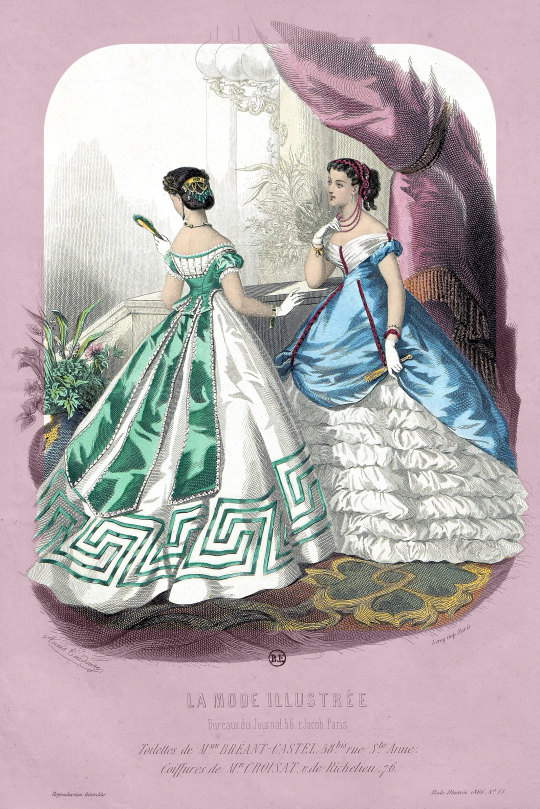
La Mode illustrée, no. 13, 25 mars 1866, Paris. Toilettes de Mme Bréant-Castel, 58 bis. rue Ste. Anne. Coiffures de Mr. Croisat, r. de Richelieu, 76. Ville de Paris / Bibliothèque Forney
Description de toilettes:
Toilette de jeune fille. Robe en gaze de soie blanche; le bord est orné avec une très-large bordure grecque ayant environ 40 centimètres de hauteur, exécutée en ruban de taffetas vert. Corsage décolleté en taffetas vert, formant par derrière trois basques repliées en dessous, et se prolongeant en autant de pans très-longs et très-larges, entièrement encadrés avec une étroite guipure. Cluny blanche qui borde aussi les contours du corsage; celui-ci est complété par une chemisette bouillonnée, traversée à distances régulières par un étroit ruban de velours vert. Manches courtes en taffetas vert; peigne de métal pour retenir les cheveux.
Robe de dessous en taffetas blanc, garnie avec huit bouillonnés en gaze blanche. Robe de dessus (forme princesse) en poult-de-soie bleu vif, à corsage décolleté, garni avec une draperie de gaze blanche; cette draperie est retenue sur les épaules par une chaîne de corail rose. La robe bleue est relevée très-haut, sur chaque côté, avec des chaînes en corail rose; derrière, cette robe reprend sa longueur. La coiffure est ornée de chaînes en corail rose, disposées en bandelettes, et fixées sur chaque côté du chignon de façon à garnir le cou par devant. Agrafes de corail rose dans les cheveux; bracelets en môme corail.
—
Girl's ensemble. Dress in white silk gauze; the edge is adorned with a very wide Greek border about 40 centimeters high, executed in ribbon of green taffeta. Low-cut bodice in green taffeta, forming from behind three basques folded below, and extending into as many very long and very wide sections, entirely framed with a narrow guipure. Cluny white which also lines the contours of the bodice; this is completed by a buttoned shirt, crossed at regular intervals by a narrow green velvet ribbon. Short sleeves in green taffeta; metal comb to hold the hair.
Underdress in white taffeta, trimmed with eight white gauze bubbles. Overdress (princess form) in bright blue poult-de-silk, with a low-cut bodice, trimmed with a drapery of white gauze; this drapery is held on the shoulders by a chain of pink coral. The blue dress is raised very high, on each side, with pink coral chains; behind, this dress regains its length. The hairstyle is adorned with pink coral chains, arranged in strips, and fixed on each side of the bun so as to adorn the neck in front. Clips of pink coral in the hair; kid coral bracelets.
#la mode illustrée#19th century#1800s#1860s#1866#periodical#fashion#fashion plate#color#retouch#description#Forney#dress#toilette#ensemble#Bréant-Castel#taffeta#underdress#gauze#meander#guipure#cluny#pink#blue#green
156 notes
·
View notes
